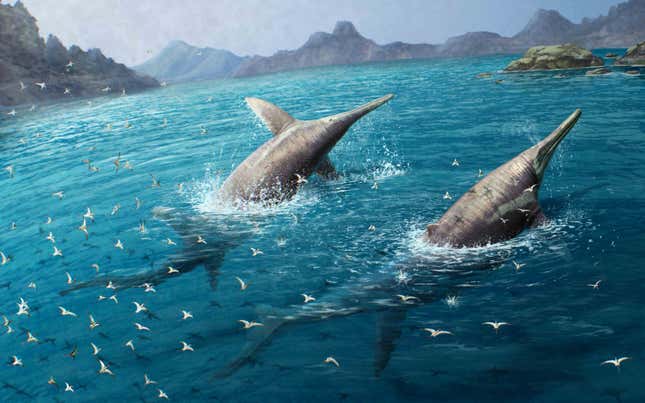A jawbone found in Somerset, England, may belong to the largest marine reptile yet known, a huge ichthyosaur that lived about 200 million years ago. The new species is dubbed Ichthyotitan severnensis and may have been over 80 feet long, according to the team’s estimates. The finding means that ichthyosaurs could have grown nearly as large as blue whales, which have long reigned as the undisputed biggest animals known to science.
The team described I. severnensis in a study published today in PLoS One. Though the animal’s length is an educated guess based on the size of its jawbone, if the estimates are correct then the newly described species could grow about 10 feet longer than S. sikanniensis, the next largest ichthyosaur.
Advertisement
Ichthyosaurs were ancient, sea-dwelling reptiles that disappeared about 90 million years ago. Though they shared the planet with dinosaurs—bar the last 30-million-odd years of the latter’s tenure—ichthyosaurs belong to a different branch on the tree of life. The largest ichthyosaurs were the shastasaurids, a group that ranged in size from about 20 feet (6 meters) long to over 60 feet (20m) long—I. severnensis being the latest, most superlative example.
Advertisement
Ichthyosaurs remains are all over Europe. In 2022, a different team of paleontologists identified three ichthyosaur fossils in the Swiss Alps, some 9,000 feet above sea level, and recent studies have revealed an ichthyosaur fossil with a fossilized embryo inside it and even on ichthyosaur with its last meal still halfway down its gullet. But only the shastasaurids reached gargantuan size—not quite as big as blue whales, the largest animals ever known, but bigger than sperm and humpback whales.
Advertisement
There was “an interesting diversity of very big ichthyosaurs at the end of the Triassic, just before the mass extinction 201 million years ago,” Heinz Furrer, a paleontologist at the University of Zürich and co-author of the paper on the alpine ichthyosaur finds, told Gizmodo in 2022. “Together with a nearly time-equivalent find in British Columbia, they were the biggest marine reptiles that ever lived on Earth.”
Last week, paleontologists from the University of Bonn published a study in PeerJ confirming that several large chunks of bone found across Europe over the last 150 years belonged to giant ichthyosaurs, rather than dinosaurs. Indeed, evidence of shastasaurids mainly pops up in their fossilized teeth and vertebrae.
Advertisement
“The fossils were and still are so tantalizing that I like to liken them to ghosts,” said Martin Sander, lead author of the 2022 ichthyosaur paper and co-author of last week’s work, in an email to Gizmodo. “Dominating the world’s ocean for 25 million years before the end of the Triassic (202 [million years ago]) but we hardly know what they looked like!”
In 2018, a team described a 205-million-year-old jawbone from the same stretch of Somerset, in England. They compared the jawbone with the same bone in Shonisaurus sikanniensis, the largest known ichthyosaur, which grew to about 70 feet long. The 2018 jawbone was a bit bigger, indicating the animal it belonged to was even more giant than S. sikanniensis.
Advertisement

“We had hoped that one day another [jawbone] would come to light,” said Dean Lomax, a paleontologist at the University of Manchester and lead author of the paper, in a PLOS release. “This new specimen is more complete, better preserved, and shows that we now have two of these giant bones (called a surangular) that have a unique shape and structure.”
Advertisement
In a fun bonus, the jaw bone—a surangular, to be specific—also contained several bivalve fossils and trace fossils, evidence of probable scavenging by other ancient creatures.
The largest animal ever known to exist is the blue whale, which can grow to about 100 feet long (30.5 meters) and weigh about 200 tons. The blue whale still swims in Earth’s oceans today, though it is endangered. Of course, the whale is also a mammal. Though the I. severnensis size estimate is shy of the blue whale’s length, it closes the gap. It’s also way, way bigger than the largest extant marine reptile, the saltwater crocodile, which can grow to about 17 feet long—still smaller than the smallest shastasaurids.
Advertisement
“Lomax et al decided to give the ghost a name, Ichthyotitan,” Sander said. “I think that’s a good idea although it still remains a ghost, but it is easier to talk about a ghost with a name than a nameless one.”
More: Fossils of Giant Dolphin-Like Marine Reptiles Found in Swiss Alps
Services Marketplace – Listings, Bookings & Reviews